Study compared two extruded 40 percent protein feed formulations
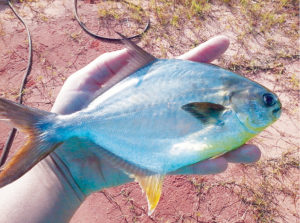
A number of countries conduct commercial production of several species of pompano. In Asia, the golden pompano (Trachinotus blochii) and similar species have been successfully produced for some time. Interest in the United States is due in part to the high market price of local species. In 2011, the annual U.S. landings of Florida pompano (T. carolinus) were valued just under $1 million, averaging $8.92/kg. Fillets of Florida pompano are reported to cost $35-45/kg in some retail markets.
Aquaculture nutrition research on Florida pompano has included work on dietary protein, amino acid and lipid levels, and digestibility of select ingredients, as well as the use of alternative feed ingredients to replace fishmeal. Through systematic research, the authors have achieved good growth using a fishmeal-free diet for the carnivorous marine fish Florida pompano.
Fishmeal replacement
Fishmeal is one of the most complete nutrient sources for animal feeds. Due to limited supply and the continued expansion of the aquaculture industry, replacing fishmeal with alternative proteins has become a key factor for the long-term sustainability of the aquaculture industry.
Soybean meal, which accounts for 67 percent of the world’s total protein meal production including fishmeal, is a key component of fish feeds. The next most common protein sources are rapeseed (14 percent) and cottonseed meal (11 percent). In general, the primary disadvantages of plant protein sources are their moderate protein levels, low levels of methionine and exceptionally low levels of taurine.
Previous research has indicated that several marine fish species have a dietary requirement for taurine that appears to be a limiting factor in some feed formulations. Palatability and anti-nutritional compounds can also limit the use of plant-based protein sources.
In the case of soy, the solvent extraction process used to produce soybean meal and soy protein concentrate removes many of the anti-nutritional factors that can affect digestibility and palatability. As nutrient limitations are worked out for each species, the potential inclusion level of alternative proteins is increasing. However, many producers wonder about the cost effectiveness of these feeds.
Experimental diets
The authors used Florida pompano as a model marine species in a cost/benefit analysis of two diets. The goal was to compare two extruded 40 percent protein feed formulations: one with a moderate level of fishmeal and the other a soy-based diet without fishmeal and including a taurine supplement. Their compositions and amino acid profiles are shown in Table 1 and 2.
Rhodes, Percentage composition, Table 1
| Soy-Based Diet | Fishmeal-Based Diet |
|---|
Soy-Based Diet | Fishmeal-Based Diet | |
|---|---|---|
| Menhaden fishmeal | 0 | 20.00 |
| Poultry by-product meal | 15.00 | 0 |
| Meat and bone meal | 0 | 10.00 |
| Soybean meal, solvent-extracted | 47.50 | 35.00 |
| Menhaden fish oil | 4.80 | 3.81 |
| Whole wheat | 23.94 | 29.24 |
| Corn gluten meal | 4.00 | 0 |
| Trace mineral premix | 0.10 | 0.10 |
| Vitamin premix | 0.40 | 0.40 |
| Choline chloride | 0.20 | 0.20 |
| Vitamin C, 250 mg/kg | 0.10 | 0.10 |
| Calcium phosphate, dibasic | 2.00 | 0 |
| Lecithin | 1.00 | 1.00 |
| Methionine | 0.06 | 0 |
| Taurine | 0.75 | 0 |
| Mold inhibitor | 0.15 | 0.15 |
| Analyzed crude protein | 41.90 | 43.60 |
| Acid hydrolysis fat | 7.00 | 7.00 |
| Cost (U.S. $/kg)* | 1.023 | 1.149 |
Rhodes, Percentage composition, Table 2
| 2011 Diets Amino Acid | 2011 Diets Soy-Based Diet | 2011 Diets Fishmeal-Based Diet | 2012 Diets Soy-Based Diet | 2012 Diets Fishmeal-Based Diet |
|---|
2011 Diets Amino Acid | 2011 Diets Soy-Based Diet | 2011 Diets Fishmeal-Based Diet | 2012 Diets Soy-Based Diet | 2012 Diets Fishmeal-Based Diet |
|---|---|---|---|---|
| Alanine | 2.01 | 2.16 | 2.05 | 1.92 |
| Arginine | 2.40 | 2.63 | 3.06 | 3.06 |
| Aspartic acid | 3.03 | 3.57 | 3.39 | 3.65 |
| Cystine | 0.62 | 0.51 | 0.55 | 0.47 |
| Glutamic acid | 6.76 | 7.08 | 6.59 | 5.85 |
| Glycine | 2.38 | 2.64 | 2.11 | 2.06 |
| Histidine | 1.32 | 1.52 | 0.95 | 0.94 |
| Isoleucine | 1.51 | 1.38 | 1.37 | 1.45 |
| Leucine | 2.58 | 2.93 | 2.90 | 3.08 |
| Lysine | 2.49 | 2.79 | 2.24 | 2.38 |
| Methionine | 0.72 | 0.72 | 0.61 | 0.65 |
| Phenylalanine | 1.74 | 1.77 | 2.03 | 1.98 |
| Proline | 2.66 | 3.35 | 2.86 | 2.18 |
| Serine | 1.70 | 2.57 | 2.26 | 2.14 |
| Threonine | 1.51 | 2.09 | 1.64 | 1.67 |
| Tyrosine | 1.89 | 1.86 | 1.41 | 1.09 |
| Tryptophan | 0.34 | 0.33 | 0.39 | 0.38 |
| Valine | – | – | 1.62 | 1.33 |
| Taurine | 0.88 | 0.13 | 0.77 | 0.06 |
The diets were manufactured at Kansas State University Extrusion Lab using a pilot-scale twin-screw extruder equipped with a differential-diameter cylinder pre-conditioner. Due to differences is ingredient matrix, the diets were manufactured under slightly different conditions. Most notably, the soy-based feed had a higher level of external lipids in the form of fish oil (4.8 versus 3.8 percent in the fishmeal diet) and less starch in the form of whole wheat. The combination of these two factors was probably the reason for the observed lower expansion in the soy product and the need to modify extrusion conditions.
While lipids tend to coat the ingredient particles and reduce heat or steam absorption, they also provide lubricity to the extrusion melt, thus reducing the motor load and associated energy requirements.
Growth trials
Three growth trials were conducted in recirculating systems at the Claude Peteet Mariculture Center in Gulf Shores, Ala., USA. In 2011, a small-scale trial was conducted inside a greenhouse that contained 12, 1-cubic-meter circular fiberglass culture tanks, a 1.0-cubic-meter reservoir tank, bead filter, water pump and supplemental aeration supplied by a regenerative blower and air diffusers. Juvenile pompano weighing about 11.07 grams each were stocked at 20 fish/tank.
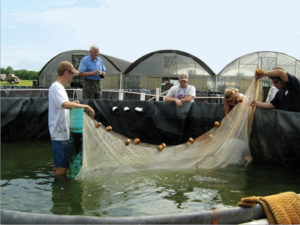
In 2012, to demonstrate the diets under commercial conditions, an outdoor recirculating system consisting of six, 30-cubic-meter culture tanks, reservoir tanks, bead filter, foam fractionation and circulation pumps was utilized. Each tank was stocked with 120 fish. To allow better replication and control over diseases and other production problems, a parallel trial was managed in an indoor recirculating system containing six, 5-cubic-meter culture tanks stocked with 55 fish/tank.
The fish were fed to satiation four times daily to maximize growth and feed utilization. The trials were conducted for 11 weeks in the outdoor system and 14 weeks in the indoor system. The experimental systems provided a natural light cycle with 14 hours of light and 10 hours of darkness daily. Routine systems maintenance consisted of partial water exchanges, backwashing filters and siphoning of solids as needed. Experimental fish were sampled every two weeks for performance evaluation and to adjust feed input.
Water quality parameters were monitored routinely to maintain suitable water system containing six, 5-cubic-meter culture tanks stocked with 55 fish/tank.
The fish were fed to satiation four times daily to maximize growth and feed utilization. The trials were conducted for 11 weeks in the outdoor system and 14 weeks in the indoor system. The experimental systems provided a natural light cycle with 14 hours of light and 10 hours of darkness daily. Routine systems maintenance consisted of partial water exchanges, backwashing filters and siphoning of solids as needed. Experimental fish were sampled every two weeks for performance evaluation and to adjust feed input.
Water quality parameters were monitored routinely to maintain suitable water quality for this species. The water quality for the trials remained at acceptable levels (Table 3).
Rhodes, Water quality parameters, Table 3
| 2011, 1-m3 tanks | 2012, 5-m3 tanks | 2012, 30-m3 tanks |
|---|
2011, 1-m3 tanks | 2012, 5-m3 tanks | 2012, 30-m3 tanks | |
|---|---|---|---|
| Temperature (° C) | 28.4 ± 1.7 | 27.9 ± 2.3 | 30.1 ± 2.0 |
| Salinity (ppt) | 19.7 ± 2.0 | 25.4 ± 3.4 | 20.1 ± 3.4 |
| Dissolved oxygen (mg/L) | 5.3 ± 0.5 | 5.8 ± 0.5 | 6.2 ± 0.9 |
| pH | 7.9 ± 0.3 | 7.8 ± 0.2 | 8.0 ± 0.5 |
| Total ammonia nitrogen (mg/L) | 0.1 ± 0.2 | 0.1 ± 0.1 | 0.1 ± 0.2 |
Results
The 2011 trial, conducted for 16 weeks, showed growth parameters were similar when the fish were fed the different diets (Table 4). Again in 2012, the fish in both grow-out trials fed aggressively and had good growth performance. The growth parameters were similar for the different diet treatments (Table 4). There was no significant difference among the trials for final weight, weight gain or survival.
Rhodes, Performance of juvenile Florida pompano, Table 4
| Initial Weight (g) | Final Weight (g) | Weight Gain (%) | Survival (%) | Feed-Conversion Ratio | Hematocrit (%) | Cost ($/kg fish) |
|---|
Initial Weight (g) | Final Weight (g) | Weight Gain (%) | Survival (%) | Feed-Conversion Ratio | Hematocrit (%) | Cost ($/kg fish) | |
|---|---|---|---|---|---|---|---|
| Indoor 1-m3 tanks, 16 weeks | |||||||
| Soy-based diets | 11.0 | 140.3 | 1,177.0 | 92.5 | 2.01 | 56.5 | 1.73 |
| Fishmeal-based diets | 11.1 | 139.5 | 1,158.2 | 88.8 | 2.14 | 50.3 | 2.10 |
| Indoor 5-m3 tanks, 14 weeks | |||||||
| Soy-based diets | 20.1 | 106.4 | 429.9 | 71.8 | 2.97 | 51.6 | 3.10 |
| Fishmeal-based diets | 19.9 | 109.1 | 446.7 | 58.2 | 2.67 | 52.1 | 4.26 |
| Outdoor 30-m3 tanks, 11 weeks | |||||||
| Soy-based diets | 25.0 | 121.6 | 385.6 | 91.3 | 2.62 | – | 2.06 |
| Fishmeal-based diets | 24.9 | 115.8 | 364.9 | 85.0 | 2.98 | – | 2.57 |
The high inclusion rates of soybean meal supplemented with taurine supported good pompano growth. The estimated feed cost in 2011 for the soy diet was $0.908/kg, and the fishmeal diet cost was $0.967/kg. While the cost to manufacture the diets was not significantly different, the feed cost per kilogram of fish produced was significantly less when using the soy-based diet.
In 2011, the average feed costs for fish grown 16 weeks were $1.73 and $2.10/kg for the soy and fishmeal diets, respectively, with mean fish weights of 140 grams. For 2012, the estimated feed cost for the soy diet was $1.023/kg and for the fishmeal diet was $1.149/kg.
There is an abundant supply of taurine, so the addition of taurine to fishmeal-free diets did not substantially increase costs. The taurine only added an additional $1.55/45 kg feed manufactured.
In 2012, average feed costs for fish grown were significantly different: $2.06 and $2.57/kg for the soy and fishmeal diets, respectively. For the indoor trial, the costs per kilogram of fish were $3.10 and $4.26 for the soy and fishmeal feeds, respectively, which were not significantly different.
The pompano did not reach the market size of 450 grams during the grow-out trials. Therefore, the feed cost to produce marketable fish was not calculated. More research needs to be conducted on pompano over 150 grams.
(Editor’s Note: This article was originally published in the September/October 2013 print edition of the Global Aquaculture Advocate.)
Now that you've reached the end of the article ...
… please consider supporting GSA’s mission to advance responsible seafood practices through education, advocacy and third-party assurances. The Advocate aims to document the evolution of responsible seafood practices and share the expansive knowledge of our vast network of contributors.
By becoming a Global Seafood Alliance member, you’re ensuring that all of the pre-competitive work we do through member benefits, resources and events can continue. Individual membership costs just $50 a year.
Not a GSA member? Join us.
Authors
-
Melanie A. Rhodes
Auburn University
Department of Fisheries and Allied Aquacultures
Auburn University, Alabama, USA -
Terry Hanson, Ph.D.
Auburn University
Department of Fisheries and Allied Aquacultures
Auburn University, Alabama, USA -
Sajid Alavi, Ph.D.
Kansas State University
Department of Grain Science and Industry
Manhattan, Kansas, USA -
D. Allen Davis, Ph.D.
Auburn University
Department of Fisheries and Allied Aquacultures
315 Swingle Hall
Auburn University, Alabama 36849-5419 USA
Tagged With
Related Posts
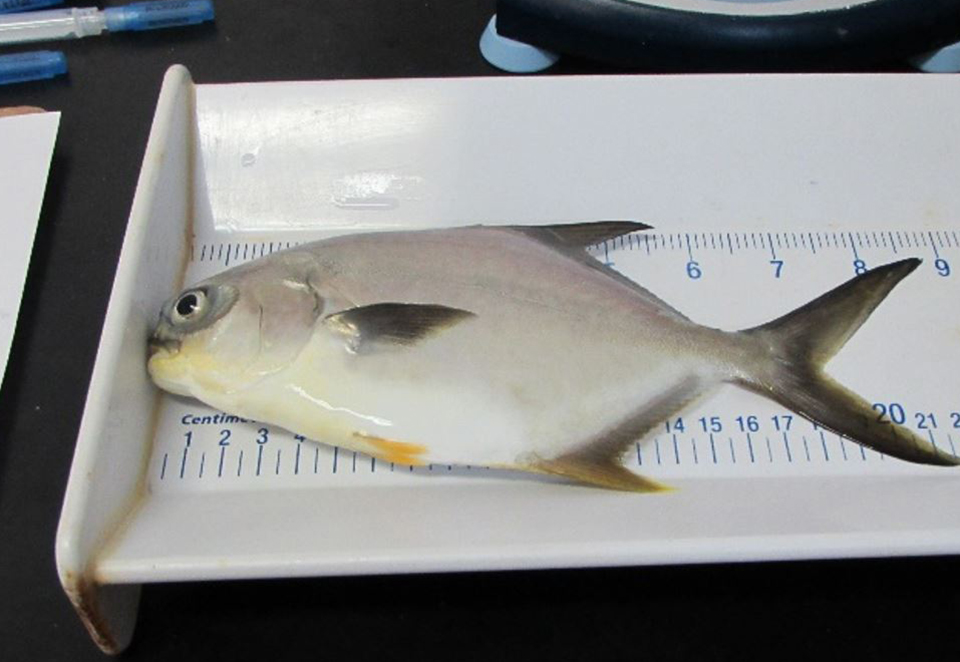
Aquafeeds
Evaluating dietary fish oil replacement in juvenile Florida pompano
Study evaluated production performance and tissue composition of juvenile Florida pompano fed diets containing fish oil or 25:75 blends of fish oil and various other lipid sources.

Aquafeeds
Replacing fishmeal with DFB in pompano diets
A study evaluated the inclusion of bacterial, dried fermented biomass as a replacement for fishmeal in four practical diets for Florida pompano juveniles. There were no significant differences in final weight, survival, FCR or thermal-unit growth coefficient.
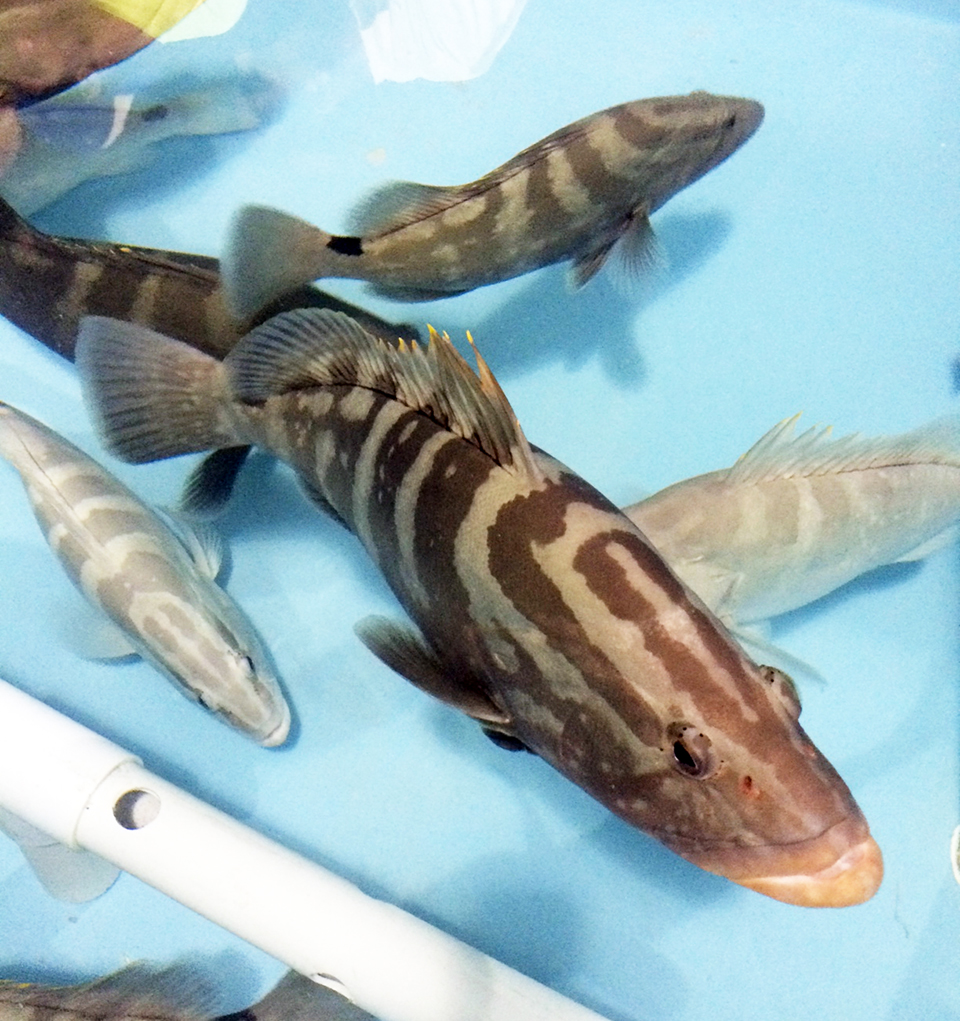
Intelligence
Bahamas venture focuses on grouper, other high-value marine fish
A new venture under development in the Bahamas will capitalize on Tropic Seafood’s established logistics and infrastructure to diversify its operations from processing and selling wild fisheries products to include the culture of grouper and other marine fish.
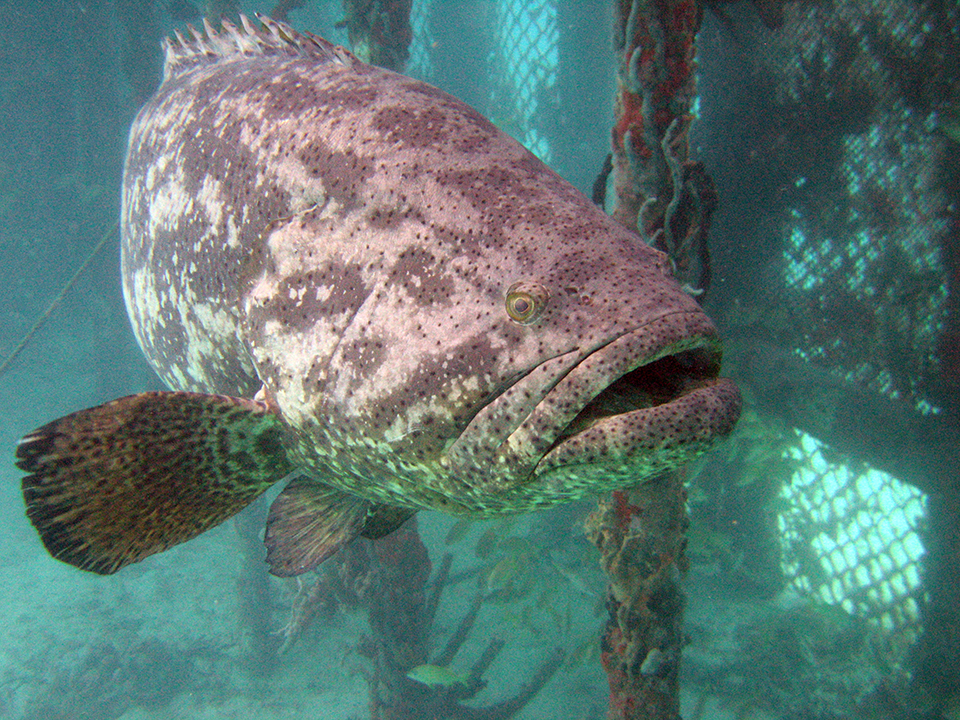
Innovation & Investment
Colombia to diversify its aquaculture industry through marine fish culture
A collaboration among the Center for Aquaculture Research in Colombia, Center for Research, Education and Recreation, and University of Miami is working to adapt the latest aquaculture technology available worldwide to local conditions and create opportunities for farming new commercial species in Colombia.



